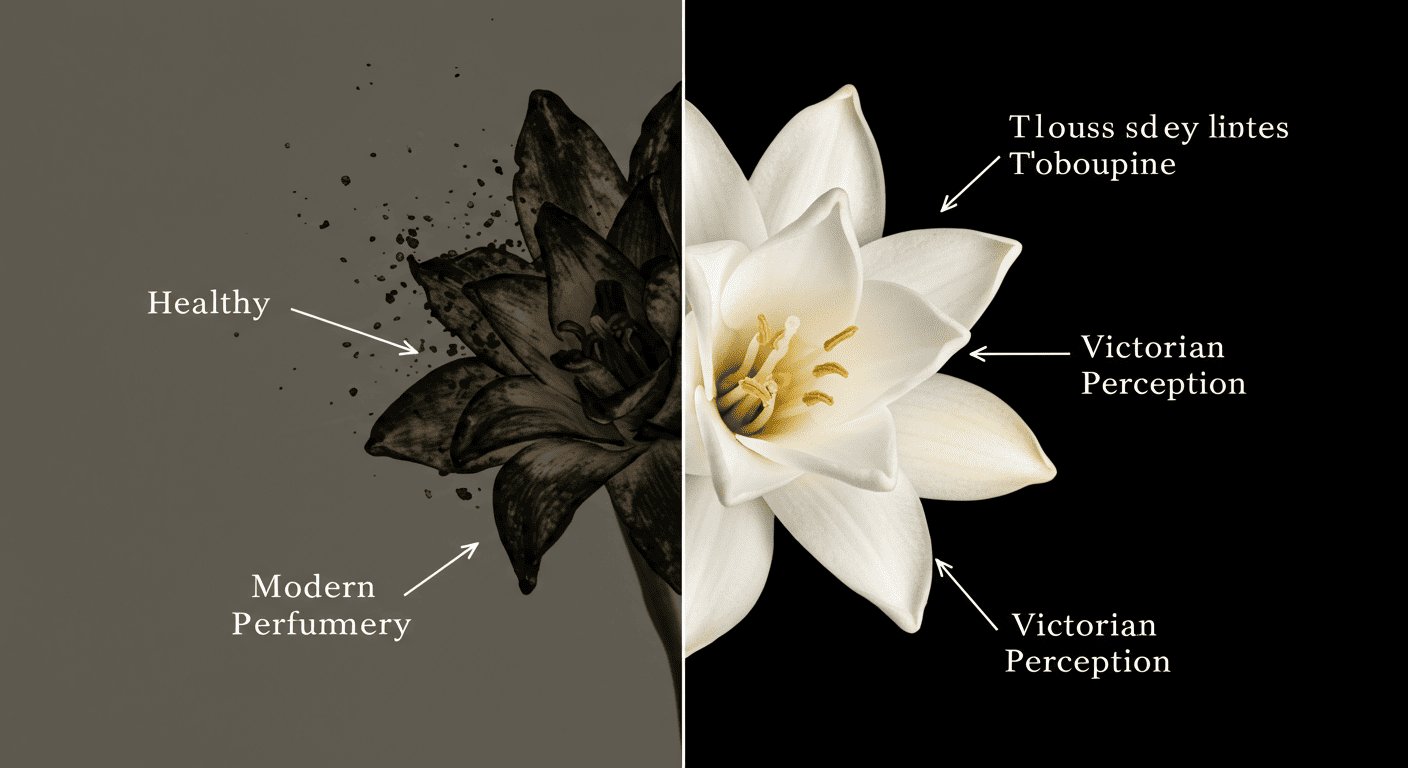The tuberose flower, with its intoxicatingly potent aroma, has always held a dramatic and dualistic reputation. In the world of perfumery, it is celebrated as one of the most opulent and sensual white floral notes, a symbol of lavishness and allure. Yet, this very same flower carried a far more sinister reputation in the past, a dark history that stands in stark contrast to its modern-day glamour. This journey from a symbol of danger to an emblem of desire reveals fascinating insights into cultural perceptions of scent.
This complex blossom, known scientifically as Polianthes tuberosa, was once branded as a “carnal flower” with a scent so powerful it was deemed hazardous to the delicate sensibilities of young Victorian women. It was a fragrance associated with moral decay and forbidden passions, a far cry from the celebrated status it holds today. Its potent, almost narcotic character made it a flower of the night, its story interwoven with tales of caution and peril.
The transformation of tuberose from a Victorian-era warning to a cornerstone of luxury fragrance is a testament to changing cultural values and the power of olfactory art. This journey from feared flower to treasured essence is mirrored in the stories of other botanical ingredients, where perceived value is often directly linked to the difficulty and cost of extraction. Understanding the most expensive ingredient technology provides insight into why certain floral notes, like those derived from the iris root, command such astronomical prices and prestige.
The Flower of Forbidden Pleasures
During the Victorian era, a period defined by its rigid social codes and moral austerity, the tuberose was regarded with deep suspicion. Its intensely sweet and heady fragrance, which blooms most powerfully after dusk, was seen as an olfactory symbol of impropriety and temptation. Young, unmarried women were often warned against inhaling its scent in a closed room, as it was believed to incite spontaneous and uncontrollable amorous feelings.
This reputation was not merely folklore; it was a genuine cultural phenomenon that cast the flower as a botanical villain. The scent was considered too bold, too animalic, and too evocative of the physical body, clashing violently with the era’s emphasis on modesty and restraint. The dangerous floral scent became a cautionary tale, a fragrant representation of the line between virtue and vice, purity and corruption.
This perception cemented the tuberose’s place as a forbidden pleasure, a flower admired for its beauty but feared for its perceived influence over human passions. It was rarely used in respectable bouquets and was instead associated with the clandestine and the morally ambiguous. This dark chapter in its history makes its modern role as a symbol of unapologetic luxury and seduction all the more remarkable.
The Chemical Composition of a Carnal Scent
The unique and powerful aroma of tuberose is not magic, but a complex chemical symphony. The flower’s scent profile is dominated by a high concentration of methyl salicylate, a compound with a sweet, slightly medicinal character, alongside other powerful molecules like lactones, which impart a creamy, coconut-like richness. It is this specific combination that gives tuberose its signature “fleshy” or carnal quality.
Unlike the lighter, fresher scents of many other white flowers, the tuberose aroma is dense and multifaceted. It possesses an almost narcotic depth that evolves over time, revealing green, spicy, and even rubbery facets beneath its initial wave of sweetness. The chemical breakdown of its essence reveals why it is so potent and polarizing:
- High levels of methyl salicylate create its distinctive sweet intensity.
- Indoles contribute a slightly animalic, narcotic note common in white florals.
- Lactones provide a creamy, almost fatty richness, enhancing its sensual character.
- Traces of eugenol add a subtle, clove-like spiciness to its profile.
It is this cocktail of potent aromatic compounds that made the Victorians so uneasy. The scent does not just suggest a flower; it evokes a warm, living presence, a quality that was considered too raw and untamed for polite society. This very complexity, once seen as a flaw, is now celebrated by perfumers as a source of endless creative inspiration.
From Pariah to Perfumery Pillar
The rehabilitation of tuberose’s image began in the 20th century, as social norms relaxed and perfumery entered a bolder, more experimental era. Visionary perfumers recognized that the flower’s controversial qualities were also its greatest strengths. They harnessed its power and complexity, transforming it from a symbol of vice into the heart of some of the most iconic and audacious fragrances ever created.
In modern perfumery, tuberose is a pillar of the white floral family, celebrated for its unmatched strength, sillage, and opulent character. It is the star of soliflore fragrances that aim to capture its multifaceted personality, and a key supporting player that adds depth and drama to complex floral bouquets. Its journey from the shadows into the spotlight of luxury is a perfect example of how artistic vision can redefine the meaning of a scent.
Today, the tuberose note is synonymous with confidence, glamour, and unapologetic femininity. It is used in fragrances that aim to make a bold statement, embodying a sense of power and allure that the Victorians could never have imagined. The flower that was once forbidden is now one of the most coveted and celebrated ingredients in the perfumer’s palette.
The Modern Face of Tuberose
The cultivation of tuberose for the fragrance industry is a meticulous and labor-intensive process, primarily centered in India, its native Mexico, and France. The flowers are harvested by hand just as they begin to open, a process that requires both skill and speed to capture the essence at its peak potency. This careful harvesting is the first step in producing the precious absolute.
Due to the flower’s delicate nature, its essence cannot be extracted using steam distillation, which would destroy the fragile aromatic compounds. Instead, producers rely on solvent extraction to create a concrete, which is then further processed to yield the final absolute. This delicate extraction process is costly and time-consuming, contributing to tuberose’s high price point and its status as a luxury ingredient.
The final product, tuberose absolute, is a thick, dark liquid that is one of the most powerful materials in all of perfumery. A single drop can transform a composition, lending it a creamy, radiant, and intensely floral heart. Its persistence and strength make it a favorite for creating fragrances with exceptional longevity and presence, ensuring its reign as the queen of carnal flowers continues.
Frequently Asked Questions
No, despite the name, tuberose is not related to the rose family. It is a member of the agave family, Agavoideae, and its English name is derived from the Latin tuberosa, referring to its tuberous root system, not its scent.
In the Victorian era, strong, sensual scents were associated with immorality and a loss of control. The potent, heady aroma of tuberose was believed to be an aphrodisiac that could overwhelm the senses and lead to improper thoughts or actions, making it symbolically “dangerous” to a young woman’s virtue and reputation.
Yes, due to the high cost of natural tuberose absolute, chemists have developed synthetic accords to replicate its scent. These accords are complex reconstructions, blending various aroma chemicals to mimic the different facets of the natural flower. While many are very effective, they often lack the unparalleled depth and complexity of the true natural extract.

